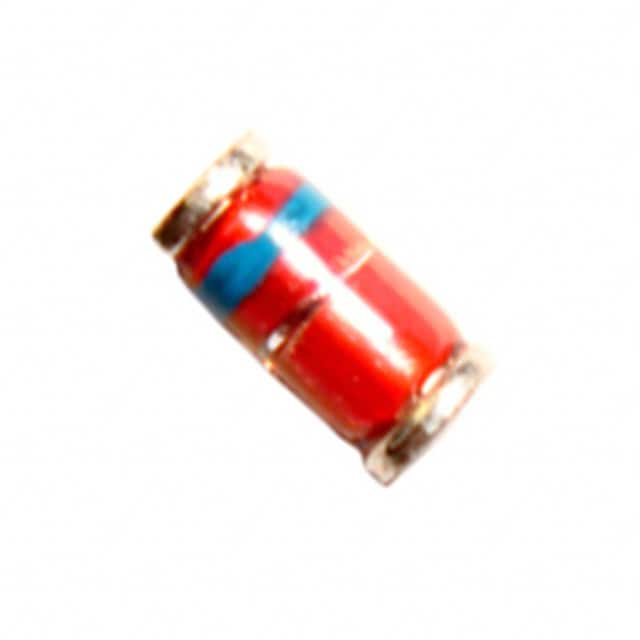Viz Specifikace pro podrobnosti o produktu.

DL4004 Product Overview
Introduction
The DL4004 is a diode belonging to the category of rectifier diodes. It is commonly used in electronic circuits for its specific characteristics and applications. This entry provides an overview of the DL4004, including its basic information, specifications, pin configuration, functional features, advantages and disadvantages, working principles, application field plans, and alternative models.
Basic Information Overview
- Category: Rectifier Diode
- Use: Used in electronic circuits for rectification purposes
- Characteristics: High current capability, low forward voltage drop
- Package: DO-41
- Essence: Silicon rectifier diode
- Packaging/Quantity: Typically available in reels or bulk packaging
Specifications
- Maximum Average Forward Current: 1A
- Peak Repetitive Reverse Voltage: 400V
- Forward Voltage Drop: 1V at 1A
- Reverse Recovery Time: 50ns
Detailed Pin Configuration
The DL4004 has a standard DO-41 package with two leads. The anode is connected to the positive terminal, and the cathode is connected to the negative terminal.
Functional Features
- Efficient rectification of AC to DC
- Low forward voltage drop minimizes power loss
- Fast reverse recovery time
Advantages and Disadvantages
Advantages
- High current capability
- Low forward voltage drop
- Fast reverse recovery time
Disadvantages
- Limited maximum average forward current
- Relatively high reverse leakage current
Working Principles
The DL4004 operates based on the principle of rectification, allowing the flow of current in one direction while blocking it in the opposite direction. When forward-biased, it conducts current with minimal voltage drop, enabling efficient conversion of AC to DC.
Detailed Application Field Plans
The DL4004 is widely used in various electronic applications, including: - Power supplies - Battery chargers - Voltage regulators - Inverters - LED lighting
Detailed and Complete Alternative Models
- 1N4001: Lower peak repetitive reverse voltage (50V)
- 1N4007: Higher peak repetitive reverse voltage (1000V)
- 1N5408: Higher maximum average forward current (3A)
In conclusion, the DL4004 rectifier diode offers efficient rectification with its unique characteristics and specifications. Its application spans across diverse electronic circuits, making it a valuable component in the realm of electronics.
Word Count: 368
Seznam 10 běžných otázek a odpovědí souvisejících s aplikací DL4004 v technických řešeních
What is DL4004?
- DL4004 is a general-purpose diode commonly used in rectifier and signal processing applications.
What are the key specifications of DL4004?
- The DL4004 has a maximum repetitive peak reverse voltage of 400V, an average forward current of 1A, and a forward voltage drop of 1V at 1A.
How is DL4004 typically used in rectifier circuits?
- DL4004 is often used as a general-purpose rectifier for converting alternating current (AC) to direct current (DC) in power supply circuits.
Can DL4004 be used for signal processing applications?
- Yes, DL4004 can be used in signal processing circuits for tasks such as clipping, clamping, and protection against voltage spikes.
What are the typical operating conditions for DL4004?
- The recommended operating temperature range for DL4004 is -65°C to +175°C, and it should be operated within its specified voltage and current limits.
Are there any common failure modes associated with DL4004?
- Common failure modes include overvoltage breakdown, excessive forward current causing thermal damage, and mechanical stress leading to physical failure.
Can DL4004 be used in high-frequency applications?
- While DL4004 can function at moderate frequencies, it may not be suitable for very high-frequency applications due to its inherent capacitance and switching characteristics.
What are some alternative diodes that can be used in place of DL4004?
- Alternatives to DL4004 include diodes such as 1N4004, 1N5404, and other general-purpose rectifier diodes with similar specifications.
How should DL4004 be handled and stored to ensure its reliability?
- DL4004 should be handled with ESD precautions and stored in a dry, non-corrosive environment to prevent degradation of its electrical properties.
What are some best practices for incorporating DL4004 into technical solutions?
- Best practices include proper heat sinking if operating at high currents, ensuring adequate voltage ratings for the application, and considering reverse recovery time in fast-switching circuits.

